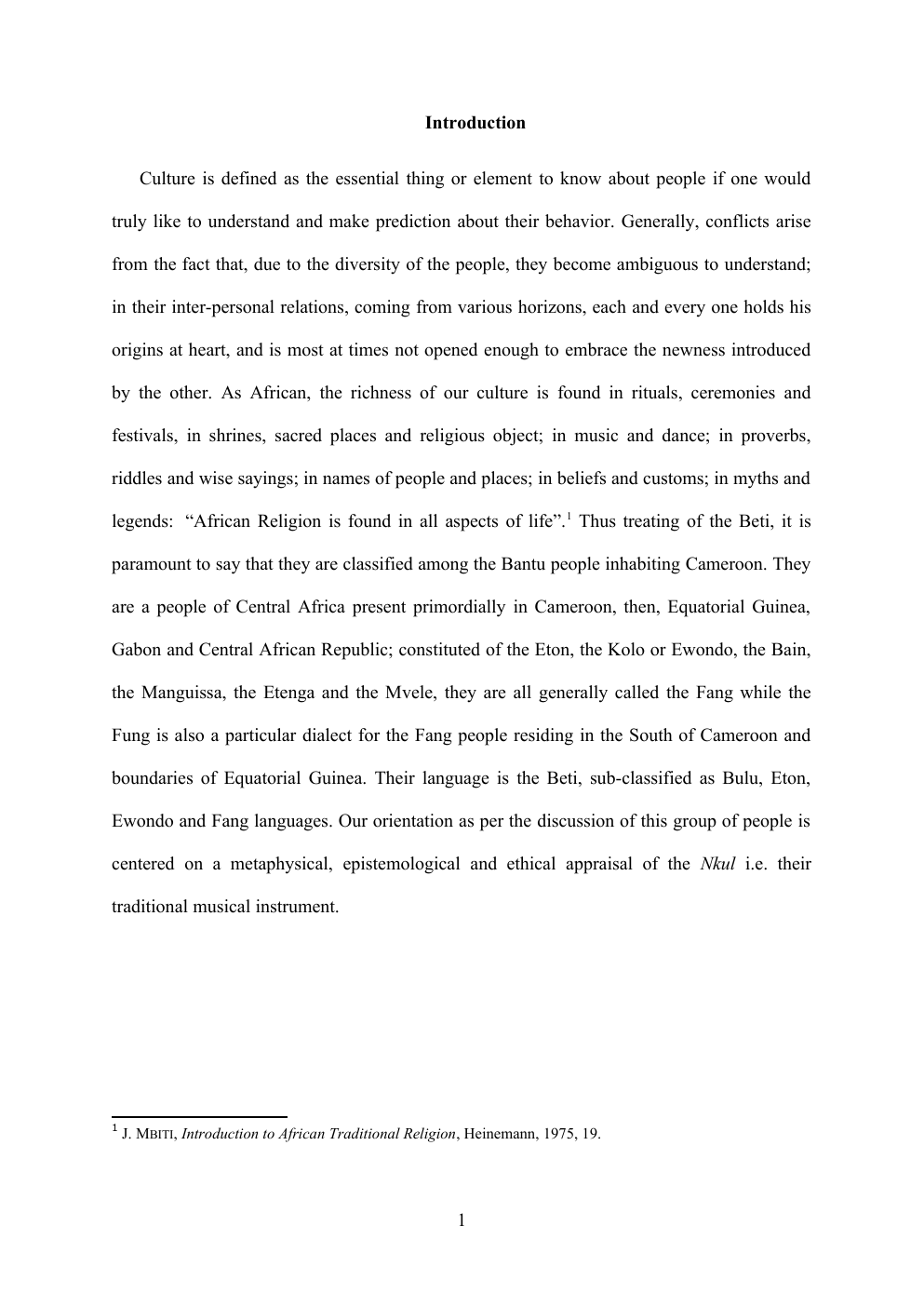African religion
Publié le 10/01/2023
Extrait du document
«
Introduction
Culture is defined as the essential thing or element to know about people if one would
truly like to understand and make prediction about their behavior.
Generally, conflicts arise
from the fact that, due to the diversity of the people, they become ambiguous to understand;
in their inter-personal relations, coming from various horizons, each and every one holds his
origins at heart, and is most at times not opened enough to embrace the newness introduced
by the other.
As African, the richness of our culture is found in rituals, ceremonies and
festivals, in shrines, sacred places and religious object; in music and dance; in proverbs,
riddles and wise sayings; in names of people and places; in beliefs and customs; in myths and
legends: “African Religion is found in all aspects of life”.
1 Thus treating of the Beti, it is
paramount to say that they are classified among the Bantu people inhabiting Cameroon.
They
are a people of Central Africa present primordially in Cameroon, then, Equatorial Guinea,
Gabon and Central African Republic; constituted of the Eton, the Kolo or Ewondo, the Bain,
the Manguissa, the Etenga and the Mvele, they are all generally called the Fang while the
Fung is also a particular dialect for the Fang people residing in the South of Cameroon and
boundaries of Equatorial Guinea.
Their language is the Beti, sub-classified as Bulu, Eton,
Ewondo and Fang languages.
Our orientation as per the discussion of this group of people is
centered on a metaphysical, epistemological and ethical appraisal of the Nkul i.e.
their
traditional musical instrument.
1
J.
MBITI, Introduction to African Traditional Religion, Heinemann, 1975, 19.
1
1.
HISTORICAL BACKGROUND OF THE BETIS PEOPLE
The name Beti derives from nti of which it constitutes the plural, nti meaning lord.
The Betis are therefore a society of lords.
But the term nti has another meaning: it also means
“nonchalant in the sense of one who obeys with majestic heaviness.” The Beti community is
one of the largest ethnic groups in Cameroon.
Settled in the central, southern and part of the
eastern regions of Cameroon and neighbour countries (Gabon and Equatorial Guinee).
They
basically have a common history; that of the crossing of the Sanaga river that we will present
later.
When we speak of the Beti, we cannot forget to mention the name of the one who is at
the origin of this community: Nanga.
This is the reason why we talk about "Beti Be Nanga",
their common ancestor who was an albino.
He had seven children among whom: Kolo Beti,
Eton Beti, Mvele Beti, Mvan Beti, Meka Beti (the Maka), Bulu the daughter, and Ntumu, the
last born.
They are descendants of Bantu origin.2
The origin of the Betis is difficult to define, but no one can say more than
themselves who they are.
The most commonly accepted thesis is the origin given by oral
tradition.
Today, the main Betis tribes are the Eton, the Ewondos, the Benes who are direct
brothers.
Originally all Betis spoke a language called Ati.
Arrived in Yaoundé, they
dispersed, some Eton found themselves in Nkometou (a region of Yaoundé).
Their migrations
were aimed at finding rich lands for agriculture, and getting closer to regions where there was
salt, which had become much more available with colonization.
It is with this in mind that the
Etons went in particular to Douala and there they encountered the Bassas who lived on this
side of the country.
The Beti are traditionally sedentary, farmers, and blacksmiths.3
2.
BETI TAM-TAM: NKUL
2
3
https://web.facebook.com/DreamtourCamer/posts/1085087458538659/
Ibid.
2
2.1.
DESCRIPTION AND SIGNIFICANT
The Nkul is the main means of telecommunication among the Beti.
It is a monoxyle
slit drum which gives two tones.
It is made from two very large trees in the forest called the
ebe commonly known as mukumari and mbel (padouk).
It often takes the name of esil (the
questioner) when it is cut for this purpose.
This wood with vermilion sap, is considered to be
a great bearer of life; this is why the skul is regarded as a reclining man who speaks through
his mouth.
A slit separates the two lips respecting a median bridge which then gives two
regulating tabs.
In making the Nkul, the craftsman must patiently pop out the sides inside the
Nkul using the wood chisel and a very heavy mallet, then pop out the two lips, polish the
whole, thin the middle bridge and separate it in two strips with a blow of red-hot machetes.
This complicated work is doubled by rites intended to make the Nkul “speak well”.
Its
extremities are whitened with Kaolin, one of the sides is carried away so that its voice carries....
»
↓↓↓ APERÇU DU DOCUMENT ↓↓↓
Liens utiles
- Une religion peut elle être plus vraie qu'une autre ?
- Relationship between religion, spirituality, and young Lebanese university students’ well-being.
- : En quoi ce passage est-il une parodie des romans de chevalerie et une satire de la religion ?
- ANTHROPOLOGIE POLITIQUE ET SOCIALE. THEME : LE MOUVEMENT ALMORAVIDE ENTRE ECONOMIE ET RELIGION.
- Ethique appendice du livre I de Spinoza: déterminisme et religion

















